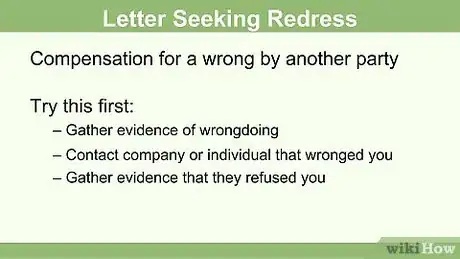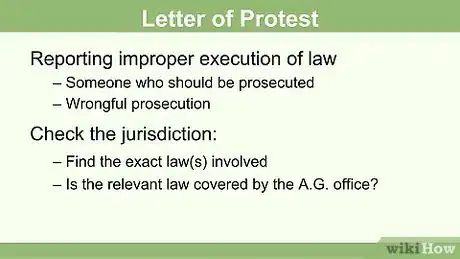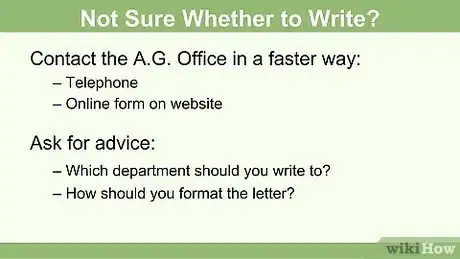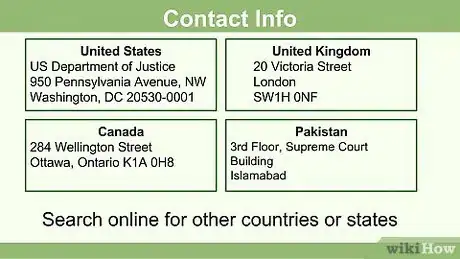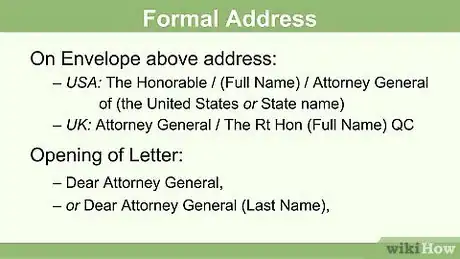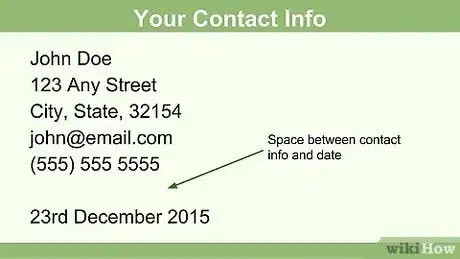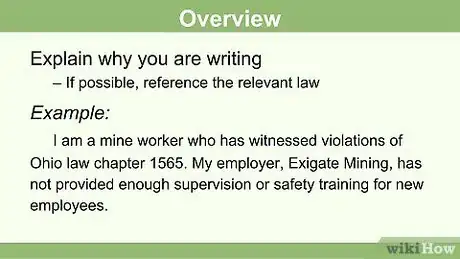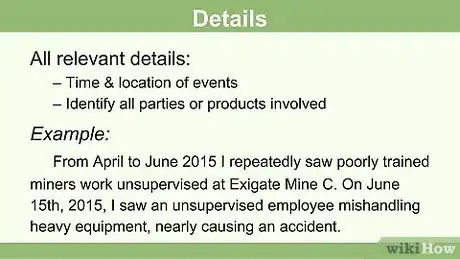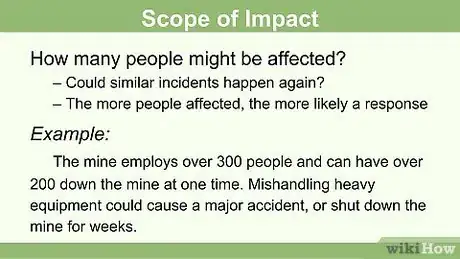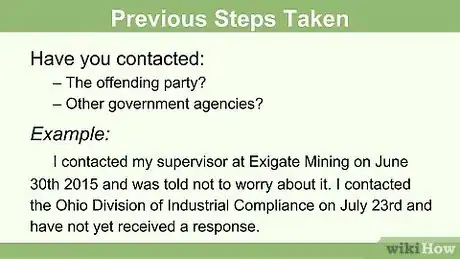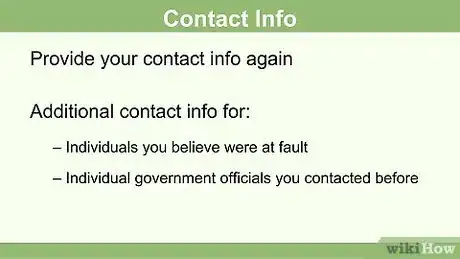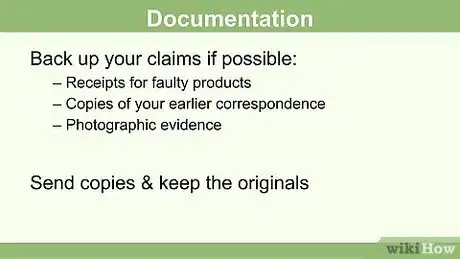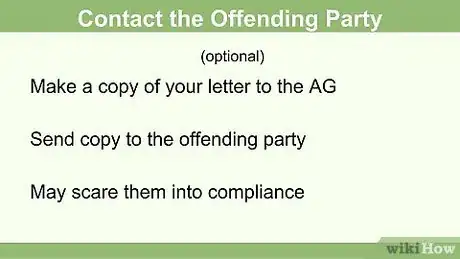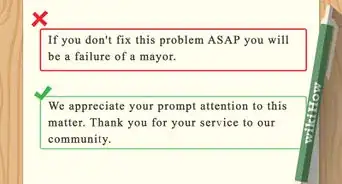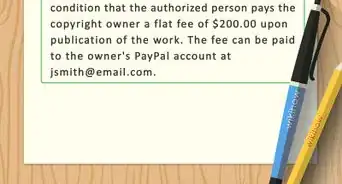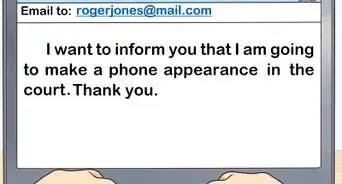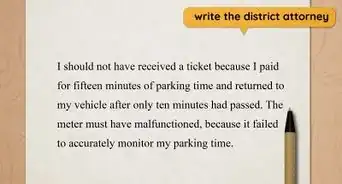This article was co-authored by Clinton M. Sandvick, JD, PhD. Clinton M. Sandvick worked as a civil litigator in California for over 7 years. He received his JD from the University of Wisconsin-Madison in 1998 and his PhD in American History from the University of Oregon in 2013.
wikiHow marks an article as reader-approved once it receives enough positive feedback. In this case, several readers have written to tell us that this article was helpful to them, earning it our reader-approved status.
This article has been viewed 130,780 times.
The Attorney General is responsible for prosecuting violations of the law under their jurisdiction. Writing a letter to the Attorney General is a last recourse in most situations. The Attorney General is only likely to respond to questions that are of wide public significance. Large scale consumer fraud or protests over public policy are the most appropriate subjects for such a letter.
Steps
Attorney General Letter Template
Knowing When to Write a Letter
-
1Seek redress from the company or individual that wronged you. Appealing to the Attorney General should be a last resort. Even ff you do eventually write the Attorney General, you will want to prove that you first approached the company in question and that they were unwilling to rectify their error. Always follow this course before writing the Attorney General
-
2Make a consumer complaint. Some examples of circumstances that would justify writing a letter include billing issues, warranties, health care complaints, privacy violations, contracts, consumer complaints, and illegal wage practices. If you have gone through the initial process of contacting the organization responsible for the unfair practice and have not received satisfactory results, then the next step may be to write a letter to the Attorney General.
- These complaints should be written to your state Attorney General, rather than the U.S. Attorney General.
- The Attorney General will most likely get involved if it is question of wide public concern. But, in writing a letter you might provide new evidence to a case the Attorney General is already building or inform him of an emerging problem.[1]
Advertisement -
3Register a protest. If you are upset with federal or state legal policy, you can send a letter of protest. When sending such a letter, you should make sure that you send it to the correct jurisdiction. For state issues, send the letter to the state Attorney General; for national issues send it to the US Attorney General.
- For letters to the Attorney General, the issue should deal with the execution of the law, not the law itself. So, if you believe that the government should be prosecuting someone but is not, the Attorney General is the person you should write.
- To determine if you should write to the state or US Attorney General use a resource like the Legal Information Institute to determine if there is a state or federal law regarding your subject of interest.[2] In general, national security or civil rights cases should be referred to the U.S. Attorney General.
-
4Call the Attorney General’s office. The office can clarify whether it would be appropriate to write an official letter of complaint. If not, they might also direct you to the appropriate legal agencies.[3]
Writing a Letter
-
1Find the Attorney General's contact information. Search online for the address of your state Attorney General. The US Attorney General has an online contact form, but you can also send a formal letter through the mail.
- The address to send a formal letter to the US Attorney General is: US Department of Justice/950 Pennsylvania Avenue, NW/Washington, DC 20530-0001.[4]
-
2Address the letter appropriately. The Attorney General is a respected official. There is a correct way to address a letter to the state or US Attorney General.
- For the Attorney General of the United States address the envelope: The Honorable/(Full name)/Attorney General of the United States/(Address). The salutation of the letter should be: Dear Attorney General (last name).
- For the Attorney General of a State address the envelop: The Honorable/(Full name)/Attorney General of (Name of State)/(Address). The salutation of the letter should read: Dear Attorney General (last name).[5]
-
3Include your contact information. Start writing your letter to the Attorney General by including your name, address and contact information at the top of your document. Skip down a few spaces and type the date followed by a few more spaces, after which you should type out the complete address to which the letter will be addressed.
-
4Start with an overview of the situation. Begin your letter with an introductory paragraph identifying yourself and stating your reasons for writing the letter. You will provide a brief introduction to the circumstances that prompted you to write your letter within this initial paragraph.
- Specify what type of action you are seeking in response within this initial paragraph. As an example, if your letter focuses on a consumer complaint, perhaps you are looking to get a full refund or a replacement for defective merchandise.
-
5Follow with a paragraph treating the details of the dispute. Outline what types of products and/or services are involved in the dispute. State the exact date and time of the purchase, the type of service or dispute in question and include the location relative to your complaint.
-
6Describe how many people were affected. If you have any reason to believe that other people were affected by the situation include a paragraph on it. The Attorney General will be more likely to involve himself in incidents that are important for the general public interest. Convey why you believe that other people have been subject to the same treatment.
-
7Describe steps you have taken. If you have already complained to the company or reached out to other government agencies, you should make the Attorney General aware of this. It is important to indicate that the responsible party is aware of the situation. Also detail any other steps you plan to take in the future.
-
8End with contact information. At the end of the letter you should provide the contact information the Attorney General should use to follow up with you. Also include the contact information of any other public officials who have knowledge of the situation.
-
9Attach documentation. Include copies of all receipts, contracts, warranties or other required documents as they may relate to your specific circumstances. Keep copies of all materials including your letter to the Attorney General.
-
10Send a copy of the letter to the offending party. Sometimes knowledge that the matter has been taken up with the Attorney General will encourage better behavior on their behalf.[6]
-
11Be patient. Realize that resolving consumer complaints takes time during the review and referral process. Depending on where you reside and your region's consumer laws, your complaint may be transferred to a consumer mediation unit.
- Receipt of your letter by the attorney general's office should generally result in a response letter sent directly to you. Depending on your situation, the letter will let you know that the Attorney General's office is reviewing your complaint and working toward a resolution.
- Understand that there may be many other consumers that have filed complaints similar to your own. In some cases, depending on your region, the Bureau of Consumer Protection may work to obtain resolution for all affected individuals, including yourself.
- If you need to contact the Attorney General's office during the review, make a note of the file number assigned to your case.
References
- ↑ https://www2.texasattorneygeneral.gov/agency/what-the-attorney-general-can-do-for-you
- ↑ http://www.justice.gov/usao/justice-101/faq
- ↑ https://www2.texasattorneygeneral.gov/agency/what-the-attorney-general-can-do-for-you
- ↑ http://www.justice.gov/contact-us
- ↑ http://www.formsofaddress.info/attorney_general.html
- ↑ https://www.naag.org/issues/consumer-protection/consumer-protection-101/

